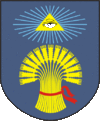Plungė
| Plungė | |||
|
|||
| State : |
|
||
| District : | Telšiai | ||
| Rajong municipality : | Plungė | ||
| Coordinates : | 55 ° 55 ' N , 21 ° 51' E | ||
| Area (place) : | 11.8 km² | ||
| Community area : | 1,105 km² | ||
| Inhabitants (place) : | 23,212 (2008) | ||
| Population density : | 1,967 inhabitants per km² | ||
| Inhabitant (municipality) : | 43,580 | ||
| Population density : | 39 inhabitants per km² | ||
| Time zone : | EET (UTC + 2) | ||
| Telephone code : | (+370) 448 | ||
| Postal code : | 90001 | ||
| Status: | Rajong Parish | ||
| Structure : | 1 city office (core city), 10 further districts |
||
| Mayor : | Elvyra Lapukiene |
||
| Postal address : | Vytauto str. 12 5640 plunge |
||
| Website : | |||
|
|
|||
Plungė ( Polish Płungiany ; Yiddish פלונגיאן, Plungian ; Russian Плунге) is a city and seat of the Rajonggeminde Plungė in Telšiai district in northwest Lithuania .
history
The place was first mentioned in 1567 , the town charter was granted in 1792 . Historically, it is located in the Lower Lithuania region . In 2009 Plungė was the cultural capital of Lithuania .
Until the German invasion of the Soviet Union, Plungė had a large Jewish community. The beginning of the settlement by Jews is unclear, but tombstones from the 16th century were found in 1937. Jews are mentioned in writing in the early 18th century by Bishop Motiejus Valančius in his History of the Diocese of Samogitia : In 1719, Bishop Aleksander Horain allowed the construction of a synagogue as long as it was less high than the Christian church. In fact, it got higher and the town priest asked for the roof to be removed. To prevent this, the Jews paid an annual tax of 30 tynfs . The synagogue is mentioned again for the year 1769.
In the middle of the 19th century, around 2,500 Jews lived in the city, and when the German troops marched in at the end of June 1941, around 1,800 Jews lived in the city. Lithuanian insurgents who fought against the occupation by the Soviet Union persecuted communists and Jews immediately after the withdrawal of the Red Army and the provisional takeover of the city administration in late June to mid-July 1941. After individual murders, the obligation of young men to do forced labor and the robbery of Jewish property by Lithuanian residents, the Jewish residents were imprisoned and ghettoized in the Great Synagogue and the shulhoyf , the Jewish community complex .
In mid-July 1941 a large fire broke out in this situation in the city for unknown reasons, for which Jews were held responsible. Immediately afterwards, from July 13-15, 1941, 2,200 Jews from the city and the surrounding area were shot and buried in mass graves. The Jewish community was wiped out with the exception of a few people who had left with the Red Army.
Economy and Infrastructure
One of the main employers in Plungė is the fish product manufacturer Vičiūnų grupė . The Plungė District Court , which had a history dating back to 1926, was dissolved in 2018.
Town twinning
Sister cities of Plungė are:
|
Born in Plungė
- Lazarus Goldschmidt (1871–1950), orientalist and scholar of Judaism
- Rosa Menzer (1886–1942), worker functionary and resistance fighter
- Bronislovas Lubys (1938–2011), industrialist, entrepreneur and politician
- Wanda Rutkiewicz (1943–1992), Polish mountaineer
- Petras Vyšniauskas (* 1957), multi-instrumentalist of modern creative jazz and university lecturer
- Rimantas Vaitkus (* 1957), politician
- Ramutė Ruškytė (* 1958), lawyer and judge
- Rasa Budbergytė (* 1960), administrative lawyer and politician
- Vitalijus Majorovas (1961–1997), Lithuanian chess player of Russian origin
- Sigitas Mitkus (* 1962), engineer, lawyer, building lawyer, professor
- Virgilijus Valančius (* 1963), lawyer, judge at the EU court
- Egidijus Baranauskas (* 1967), lawyer, lawyer, civil lawyer, professor
- Arūnas Mockus (* 1969), flotilla admiral
- Laima Domarkaitė (* 1970), chess player
- Aistė Smilgevičiūtė (* 1977), pop and folk singer
- Daiva Batytė (* 1980), chess player
- Ieva Žalimaitė (* 1992), chess player
literature
- Leonid Olschwang: The murderers are still needed . In: Der Spiegel . No. 17 , 1984, pp. 123–126 ( online - April 23, 1984 , Approximately 2000 of the 7000 population plunges were Jewish).
- Alexander Kruglov, Geoffrey P. Megargee: Plungė . In: Martin Dean (ed.): The United States Holocaust Memorial Museum Encyclopedia of Camps and Ghettos, 1933–1945 , Vol. 2: Ghettos in German-Occupied Eastern Europe , Part B. Indiana University Press, Bloomington 2012, ISBN 978- 0-253-00227-3 , p. 1105.
Web links
Individual evidence
- ^ Aliza Cohen-Mushlin: Synagogues in Lithuania N-Ž. VDA Leidykla, 2010, ISBN 978-6-094-47004-2 , p. 37 ( limited preview in the Google book search).
- ↑ a b Europe - Plungė Memorials - Telšiai District , accessed on March 3, 2019
- ↑ Glossary of terms used by the Jewish communities in Lithuania (PDF; 1.4 MB)


